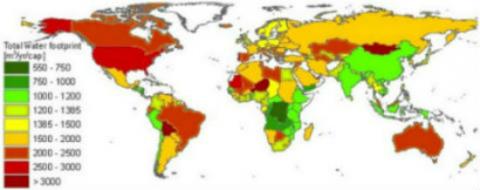By Haydée Rodríguez, legal advisor, AIDA
We live in an era of virtual creations. We have virtual reality, universities and conferences and even virtual pets. It’s no surprise then that the term “virtual water” is used more and more. But what does it mean and what’s it got to do with our everyday lives?
Virtual water is defined as the quantity of water needed to create a certain product. This estimate takes into account the volume of water consumed and contaminated in the different stages of the manufaccturing process. The United Nations estimates our daily water requirement is 2 to 4 liters per person. But it takes 2,000 to 5,000 liters to make the food that one person needs every day.
The Virtual Water Project has made estimates of the virtual water needed to make many of the products we consume daily. You can even download an application to do the calculations on your mobile phone. Here are a few numbers that caught my attention:
Our water footprint
The virtual water calculation allows us to measure our water footprint as well. The water footprint of an inpidual, business or country is the sum total of the virtual water used in making every product and service. On a per-country basis, the calculation includes the water used for domestic and industrial purposes as well as the water used in foreign countries to produce the goods and services imported and consumed by the country's inhabitants.

The map above shows the water footprint by country on a world scale (you can check out the data of every country here). It is interesting to note that developed countries like Canada that have a high level of manufacturing and imports also have a very high water footprint. Even so, according to the United Nations water availability map, not all the countries listed suffer water shortages. In general, this is becuase many products requiring high levels of water are imported and not manufactured locally, thus generating greater pressure in countries suffering from water stress: high water demand with low availability due to shortage or pollution.
You can also calculate the water footprint of inpiduals taking into account social characteristics and consumption patterns. If you want to calculate yours, you can enter your data on this link.
Virtual water, real action
Being aware of the concepts of virtual water and water footprint is important for promoting the need for more information and transparency regarding what we consume. That makes it possible for us to change our habits and choose more sustainable products with low virtual water content. We can always ask ourselves what's behind the scenes for the pair of jeans we want to buy but may not need.
Both concepts are essential for designing any strategy for protecting water and reducing the impact on aquatic ecosystems. Countries should consider the virtual water content of imported and exported products in their water resources management plans.
There is still much to learn in this field. The virtual water coming from aquifers or páramos can have a higher value and impact on populations and associated ecosystems than surface waters. To have a better idea of the pressure we put on water resources we should incorporate the economic value of the environmental services offered by the difference sources into the calculation of virtual water.
Virtual water is a tool we can use to understand the impact we have on natural resources. Even beyond what we can see, water is present in all our activities and decisions. By taking action to protect our water resources and making informed decisions, we can guarantee the human right of access to water for many people around the world.